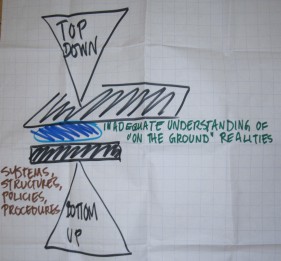A while back, I sat in on a birds-of-a-feather session on organizational change. The main theme was bemoaning the difficulty changing even mid-sized organizations.
When people talk about how hard it is to bring change there’s a tendency to blame: people who don’t turn on a dime are labeled resisters, NoNos, dinosaurs, laggards.
There certainly are people who don’t change as quickly and with as much enthusiasm as the people behind the change would like.
(I heard one agile evangelist complaining about people who weren’t embracing scrum after a two-day workshop. “I want them to drink the Kool Aid,” she declared in frustration. Yikes! I want people to consider and wrestle with a new idea, not accepted it as someone who has given up free will. I hope she was ignorant of Jonestown.)
There are many reasons people don’t change as quickly as we’d like. A few I cited in Seven Lessons for a Top Down Change:
- they don’t know how to do what they’re being asked to do.
- they don’t feel they have time to learn the new way and still meet existing goals and targets.
- they believe the existing way is better.
- they don’t think the new way will work.
- they believe the new way will cause harm—to customers, the company, the employees, etc.
- they don’t like or don’t respect the person requesting the change.
- the new suggestion is counter-intuitive given people’s existing models of how the world works.
- the new way runs counter to existing reward structures or other organizational systems.
When there’s been a failed change or a change that went badly, people may figure that they can simply wait out the change. I’ve certainly seen re-orgs done and undone within a year. And not matter how good a change looks, it’s bad for someone, somewhere in the organization.
People have a valid reason not to change–from their own point of view. Labeling them will not help.
Most change efforts take a deterministic approach to change. Set the vision, establish a sense of urgency (usually through pep talks) and then pull and push people towards the desired state. That may work with a simple change. But most change isn’t simple.
Entirely apart from the (normal) human responses to change, there are structural and systemic factors that make change difficult in organizations of any size.
So sitting there in the BOF, I thought about the times that I’ve seen top down and bottom up changes grind to a halt.
Hierarchy acts as a filter. Change from the top can stumble when the desired change doesn’t mesh with realities on the ground. Other top down changes falter when there isn’t sufficient understanding of the gravity of the need for change–what’s self-evident at the top isn’t communicated to the people being asked to change. Some popular writers on change talk about creating a sense of urgency. One SVP attempted to generate some urgency by declaring he wanted seven scrum team up and running by a certain date because it was his birthday–which generated cynicism. Urgency doesn’t come from a “vision” or from pep talks. It comes from a clear understanding of the current reality and it’s implications for the organization (and the people in the organization).

Bottom up changes peter out when they run into systems, structures, policies, and procedures that hold the current pattern firmly in place. For example, grass roots efforts to form teams can fail when HR mandates forced ranking.
From both directions, it’s critical to understand the visible and invisible structures and how they hold current patterns in place.
If you want to change patterns of behavior, you need to know something about the pattern you want to create. You have to understand how the work works, see the system and change the system. Pulling and pushing people won’t change the pattern (but it will result in the predictable responses that people have when they feel they are being pulled or pushed).







Thanks for this. It is a well thought out perspective on a very common problem. Your insight is very applicable as usual.
Nice. Thanks for posting.
“…need to know something about the pattern you want to create…” People may blame people because people are visible. Relationships between people are invisible.
So, how ideal is it to make the patterns that we want to create visible? How can one effectively do that? 🙂
An excellent point. Also invisible are the subtle structures and exchanges that influence patterns of behavior. CDE analysis helps make those visible. See:
https://estherderby.com/2010/06/shifting-the-pattern-a-systems-approach-to-change.html.
Thanks for commenting.
I find one critical aspect to leading change is to create a visceral feeling in the body of what it will be like once the change is accomplished. This allows others to have an empathetic response to what you are intending (aka “Enthusiasm is contagious”).
Even if your belief system has a hard time accepting this, just try it when you are talking to others about change and note the level of sincerity and genuineness it adds to your words.
IMO, we spend excessive effort and energy using our heads to “do change” without first tending to the alignment of our passions about what we are trying to accomplish.